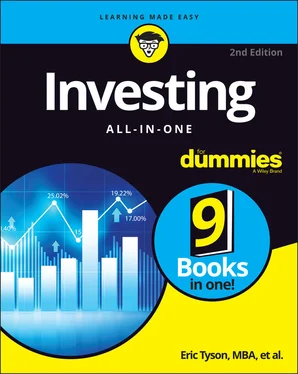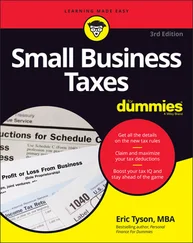Eric Tyson - Investing All-in-One For Dummies
Здесь есть возможность читать онлайн «Eric Tyson - Investing All-in-One For Dummies» — ознакомительный отрывок электронной книги совершенно бесплатно, а после прочтения отрывка купить полную версию. В некоторых случаях можно слушать аудио, скачать через торрент в формате fb2 и присутствует краткое содержание. Жанр: unrecognised, на английском языке. Описание произведения, (предисловие) а так же отзывы посетителей доступны на портале библиотеки ЛибКат.
- Название:Investing All-in-One For Dummies
- Автор:
- Жанр:
- Год:неизвестен
- ISBN:нет данных
- Рейтинг книги:3 / 5. Голосов: 1
-
Избранное:Добавить в избранное
- Отзывы:
-
Ваша оценка:
- 60
- 1
- 2
- 3
- 4
- 5
Investing All-in-One For Dummies: краткое содержание, описание и аннотация
Предлагаем к чтению аннотацию, описание, краткое содержание или предисловие (зависит от того, что написал сам автор книги «Investing All-in-One For Dummies»). Если вы не нашли необходимую информацию о книге — напишите в комментариях, мы постараемся отыскать её.
Investing All-in-One For Dummies
.
Dummies
Investing All-in-One For Dummies
Investing All-in-One For Dummies
Investing All-in-One For Dummies — читать онлайн ознакомительный отрывок
Ниже представлен текст книги, разбитый по страницам. Система сохранения места последней прочитанной страницы, позволяет с удобством читать онлайн бесплатно книгу «Investing All-in-One For Dummies», без необходимости каждый раз заново искать на чём Вы остановились. Поставьте закладку, и сможете в любой момент перейти на страницу, на которой закончили чтение.
Интервал:
Закладка:
When the stock market bubble popped during 2000–2002, it was soon replaced with the housing bubble, which popped during 2005–2006. And February 2020 witnessed a major correction (the Dow Jones industrials, for example, fell over 11 percent during the five trading days ending February 28) over fears due to the coronavirus.
Of course, you should always be happy to earn 25 percent per year with your investments, but such a return can’t be sustained and encourages speculation. In the end, spending started to slow down because consumers and businesses became too indebted. This slowdown in turn caused the sales of goods and services to taper off. Companies were left with too much overhead, capacity, and debt because they had expanded too eagerly. At this point, businesses were caught in a financial bind. Too much debt and too many expenses in a slowing economy mean one thing: Profits shrink or disappear. To stay in business, companies had to do the logical thing — cut expenses. What’s usually the biggest expense for companies? People! Many companies started laying off employees. As a result, consumer spending dropped further because more people were either laid off or had second thoughts about their own job security.
As people had little in the way of savings and too much in the way of debt, they had to sell their stock to pay their bills. This trend was a major reason that stocks started to fall in 2000. Earnings started to drop because of shrinking sales from a sputtering economy. As earnings fell, stock prices also fell.
With some hiccups along the way, the stock market has solidly zigzagged upward since the early 2000s, and the Dow Jones breached the 29,000 level in early 2020, but investors should be just as wary when the market is at nosebleed levels as they are when bear markets hit because market highs tend to be followed by the next bear market or downward move. Stock markets in February 2020 did correct painfully (a fall of 10 percent or more is a correction; a bear market is 20 percent or more), and they offered a buying opportunity for value-oriented investors.
 The lessons from the 1990s and the 2000–2020 time frame are important ones for investors today:
The lessons from the 1990s and the 2000–2020 time frame are important ones for investors today:
Stocks are not a replacement for savings accounts. Always have some money in the bank.
Stocks should never occupy 100 percent of your investment funds.
When anyone (including an expert) tells you that the economy will keep growing indefinitely, be skeptical and read diverse sources of information.
If stocks do well in your portfolio, consider protecting your stocks (both your original investment and any gains) with stop-loss orders.
Keep debt and expenses to a minimum.
If the economy is booming, a decline is sure to follow as the ebb and flow of the economy’s business cycle continues.
Staying on Top of Financial News
Reading the financial news can help you decide where or where not to invest. Many newspapers, magazines, and websites offer great coverage of the financial world. Obviously, the more informed you are, the better, but you don’t have to read everything that’s written. The information explosion in recent years has gone beyond overload, and you can easily spend so much time reading that you have little time left for investing. The following sections describe the types of information you need to get from the financial news.
 Here are some of the best publications, resources, and websites to assist you:
Here are some of the best publications, resources, and websites to assist you:
The most obvious publications of interest to stock investors are the Wall Street Journal ( www.wsj.com ) and Investor’s Business Daily ( www.investors.com ). These excellent publications report the news and stock data as of the prior trading day.
Some of the more obvious websites are MarketWatch ( www.marketwatch.com ), Yahoo! Finance ( finance.yahoo.com ), Bloomberg ( www.bloomberg.com ), and Investing.com ( www.investing.com ). These websites can actually give you news and stock data within minutes after an event occurs.
Don’t forget the exchanges’ websites that are listed in the earlier section “ Looking to Stock Exchanges for Answers.”
Figuring out what a company’s up to
Before you invest, you need to know what’s going on with the company. When you read about the company, either from the firm’s literature (its annual report, for example) or from media sources, be sure to get answers to some pertinent questions:
Is the company making more net income than it did last year? You want to invest in a company that’s growing.
Are the company’s sales greater than they were the year before? Keep in mind that you won’t make money if the company isn’t making money.
Is the company issuing press releases on new products, services, inventions, or business deals? All these achievements indicate a strong, vital company.
Knowing how the company is doing, no matter what’s happening with the general economy, is obviously important. To better understand how companies tick, see Chapter 4in Book 3.
Discovering what’s new with an industry
As you consider investing in a stock, make a point of knowing what’s going on in that company’s industry. If the industry is doing well, your stock is likely to do well, too. But then again, the reverse is also true.
Yes, some investors have picked successful stocks in a failing industry, but those cases are exceptional. By and large, it’s easier to succeed with a stock when the entire industry is doing well. As you’re watching the news, reading the financial pages, or viewing financial websites, check out the industry to ensure that it’s strong and dynamic.
Knowing what’s happening with the economy
No matter how well or how poorly the overall economy is performing, you want to stay informed about its general progress. It’s easier for the value of stock to keep going up when the economy is stable or growing. The reverse is also true: If the economy is contracting or declining, the stock has a tougher time keeping its value. Some basic items to keep tabs on include the following:
Gross domestic product (GDP): The GDP is roughly the total value of output for a particular nation, measured in the dollar amount of goods and services. It’s reported quarterly, and a rising GDP bodes well for your stock. When the GDP is rising 3 percent or more on an annual basis, that’s solid growth. If it rises but is less than 3 percent, that’s generally considered less than stellar (or mediocre). A GDP under zero (a negative number) means that the economy is shrinking (heading into recession).
The index of leading economic indicators (LEI): The LEI is a snapshot of a set of economic statistics covering activity that precedes what’s happening in the economy. Each statistic helps you understand the economy in much the same way that barometers (and windows!) help you understand what’s happening with the weather. Economists don’t just look at an individual statistic; they look at a set of statistics to get a more complete picture of what’s happening with the economy.
Seeing what politicians and government bureaucrats are doing
Being informed about what public officials are doing is vital to your success as a stock investor. Because federal, state, and local governments pass literally thousands of laws, rules, and regulations every year, monitoring the political landscape is critical to your success. The news media report what the president and Congress are doing, so always ask yourself, “How does a new law, tax, or regulation affect my stock investment?”
Читать дальшеИнтервал:
Закладка:
Похожие книги на «Investing All-in-One For Dummies»
Представляем Вашему вниманию похожие книги на «Investing All-in-One For Dummies» списком для выбора. Мы отобрали схожую по названию и смыслу литературу в надежде предоставить читателям больше вариантов отыскать новые, интересные, ещё непрочитанные произведения.
Обсуждение, отзывы о книге «Investing All-in-One For Dummies» и просто собственные мнения читателей. Оставьте ваши комментарии, напишите, что Вы думаете о произведении, его смысле или главных героях. Укажите что конкретно понравилось, а что нет, и почему Вы так считаете.












